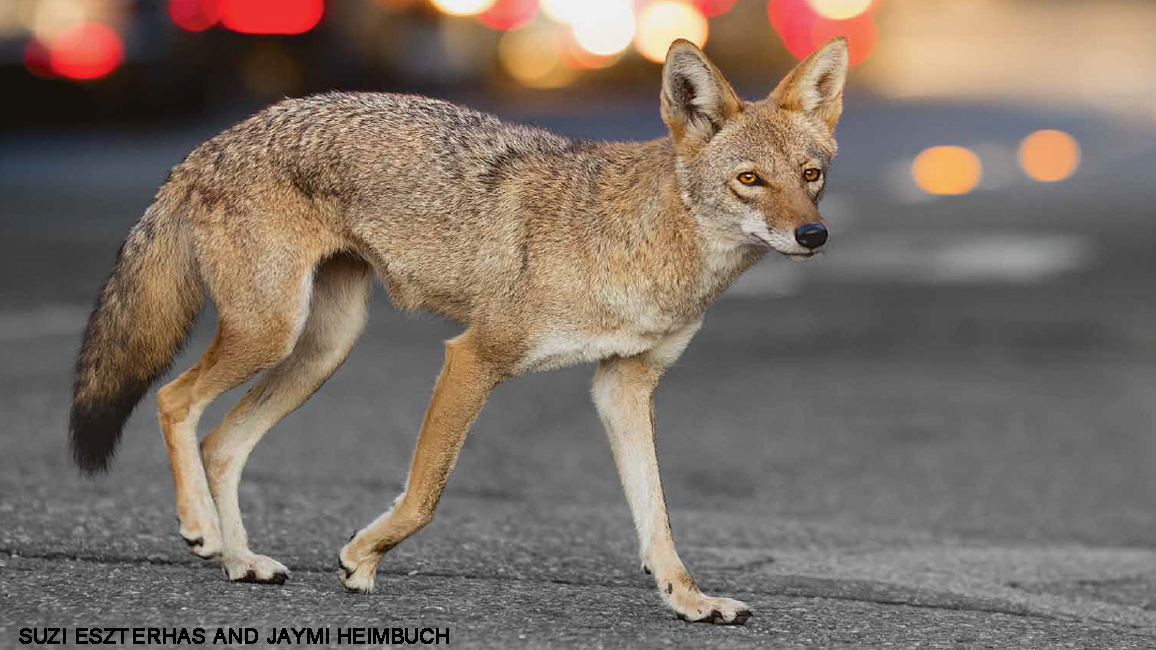
Coyotes in the City
By Robin Terry Brown; Photos by Suzi Eszterhas and Jaymi HeimbuchToday, coyotes live in almost every city and town in the United States and Canada. The more we learn about these animals, the easier it will be to share our neighborhoods with them.

If you live in or close to a city, chances are good you have some “wild” neighbors. Thousands of coyotes have moved into cities across North America, and they are showing up in some surprising places. In Chicago, one strolled right into a sandwich shop at lunchtime. Another was spotted jogging alongside an early-morning runner. And a coyote couple even raised pups in a football stadium parking garage!
Why would these wild animals want to live among skyscrapers and traffic? It turns out that cities provide everything coyotes need. The crafty creatures can make cozy homes in small patches of green space, city parks, and even storm drains. And they don’t have to look far to find food.
But coyotes have run into some trouble with their human neighbors. Spotting an occasional coyote walking down a sidewalk or hanging out in the backyard can give people quite a fright. Will the animal attack them? Does it carry a disease? Will it rummage through their garbage or, worse yet, try to turn their tabby into a kitty snack?
To find answers to these questions, wildlife expert Stan Gehrt founded the Cook County Urban Coyote Research Project. He hopes his team’s work will help people and coyotes learn to live peacefully side by side.

Stan and his project team study coyotes that live in Chicago and nearby suburbs. “We want to understand how these animals live among people and what causes conflict between them and humans,” Stan says.
Hide-and-Seek
The project’s first and biggest challenge was finding the coyotes! “These animals try to avoid people as much as possible,” Stan says. His team received tips about coyote sightings from the public and then followed the animals’ tracks and scat (poop) until they found some adult coyotes. Then they placed radio collars on the animals, so the researchers could track them through GPS. During pup season, the collared animals led the scientists straight to their dens—sort of. It still took a lot of searching to find the hidden pups. Some dens were in holes, and others were under rocks or bushes.
Coyote Check-Up
Working quickly while the parents were away, the scientists checked to see if the pups had teeth yet. (That would mean they were at least four weeks old.) Then they measured and weighed the animals to make sure they were a healthy size for their age.
Next, the scientists snipped a couple of whiskers and hairs to take back to the lab. Chemicals in the whiskers can tell what the animals were eating. And other chemicals in the hairs can show if the animals are under stress.
See Ya Later!
The scientists then inserted a small identification tag under each animal’s skin to identify the pup. “If we find the animals later as adults, we can scan the tags to find out who’s who,” Stan explains. Studying the animals over time helps the scientists learn about the coyotes’ family relationships, how long the pups stay with parents, and where the pups go when they leave the family.

Up All Night
Over time, the scientists discovered that coyotes are actually pretty good neighbors. So far, they have counted about 4,000 coyotes living in the Chicago area—a lot more than anyone knew. “That means that most of these city coyotes don’t cause any problems for people,” Stan says.
The team found out that the shy animals usually hide from people, often moving around at night to avoid them. That’s different from their cousins in the country, which are most active in mornings and evenings.
No Fast Food
People often worry that coyotes might prey on their pets or turn trash cans into all-you-can-eat buffets. But the scientists found that most coyotes chow down on natural prey instead. Some of their favorite foods are rats, young deer, and Canada goose eggs—a diet that helps to keep these troublesome animal populations under control. Coyotes also eat rabbits, lizards, and even berries and other plant parts.
Some city dwellers are also afraid that coyotes carry diseases. But actually, “coyotes living in downtown Chicago are some of the healthiest coyotes you will see,” Stan says. “They are showing us that they belong in the city.”
Know Your Neighbor
How can we learn to live with the coyote next door? “The only way that coyotes can live with us successfully is if they have a certain level of fear,” Stan says. So, if you see a coyote, yell at it and shoo it away. Don’t feed the animal or treat it like a pet dog. And because a small number of coyotes do eat garbage or small pets, it’s important to lock up trash and compost bins and keep pets—and pet food—inside at night. The more we know about coyotes, the better neighbors we will be.
















